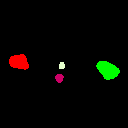Automated segmentation can assist radiotherapy treatment planning by saving manual contouring efforts and reducing intra-observer and inter-observer variations. The recent development of deep learning approaches has revoluted medical data processing, including semantic segmentation, by dramatically improving performance. However, training effective deep learning models usually require a large amount of high-quality labeled data, which are often costly to collect. We developed a novel semi-supervised adversarial deep learning approach for 3D pelvic CT image semantic segmentation. Unlike supervised deep learning methods, the new approach can utilize both annotated and un-annotated data for training. It generates un-annotated synthetic data by a data augmentation scheme using generative adversarial networks (GANs). We applied the new approach to segmenting multiple organs in male pelvic CT images, where CT images without annotations and GAN-synthesized un-annotated images were used in semi-supervised learning. Experimental results, evaluated by three metrics (Dice similarity coefficient, average Hausdorff distance, and average surface Hausdorff distance), showed that the new method achieved either comparable performance with substantially fewer annotated images or better performance with the same amount of annotated data, outperforming the existing state-of-the-art methods.
翻译:通过节省人工混凝土,减少观察者内部和观察者之间的差异,自动化分解有助于放射治疗规划; 最近开发的深层次学习方法通过大幅提高性能,使医疗数据处理,包括语义分解发生再演变化; 然而,有效的深层学习模式培训通常需要大量高质量的标签数据,这些数据收集费用往往很高; 我们为3D骨盆和CT图像分解开发了一种新的半监督的对抗性深层次学习方法; 与监督的深层次学习方法不同,新方法可以使用附加说明和未附加说明的数据进行培训; 通过使用基因化对抗网络(GANs)的数据增强计划生成了未经附加说明的合成数据; 我们采用新的方法将男性骨盆CT图像中的多器官分解开来,其中没有说明的CT图像和GAN-合成的大型未经附加说明的图像用于半监督的学习; 实验结果,用三种指标(Dice相似系数、平均Hausdovif距离和平均表面面Hausdf距离)评估。 我们采用了新的方法,用一种比较性强的成绩,即现有图像达到相当的数值。





















